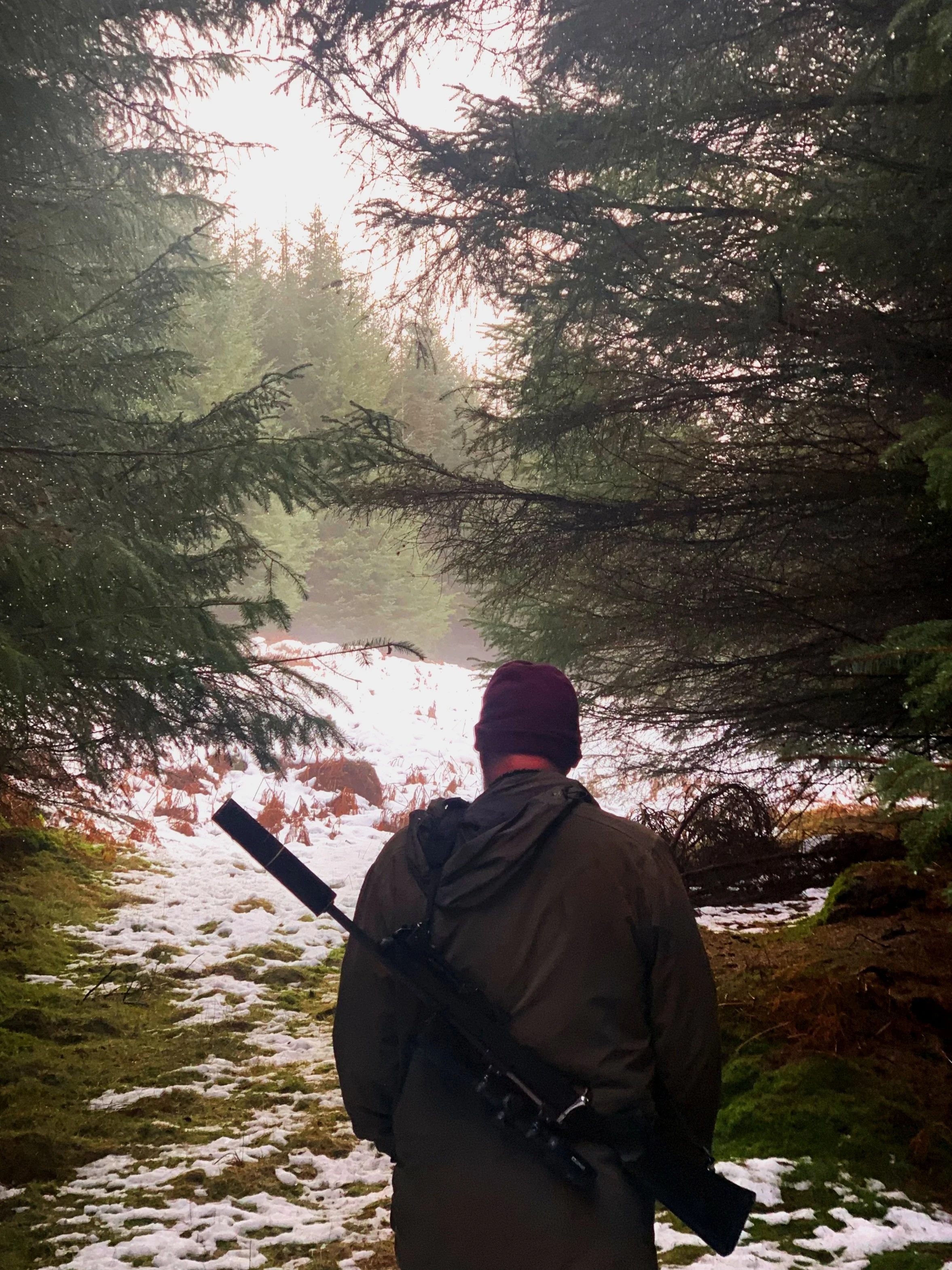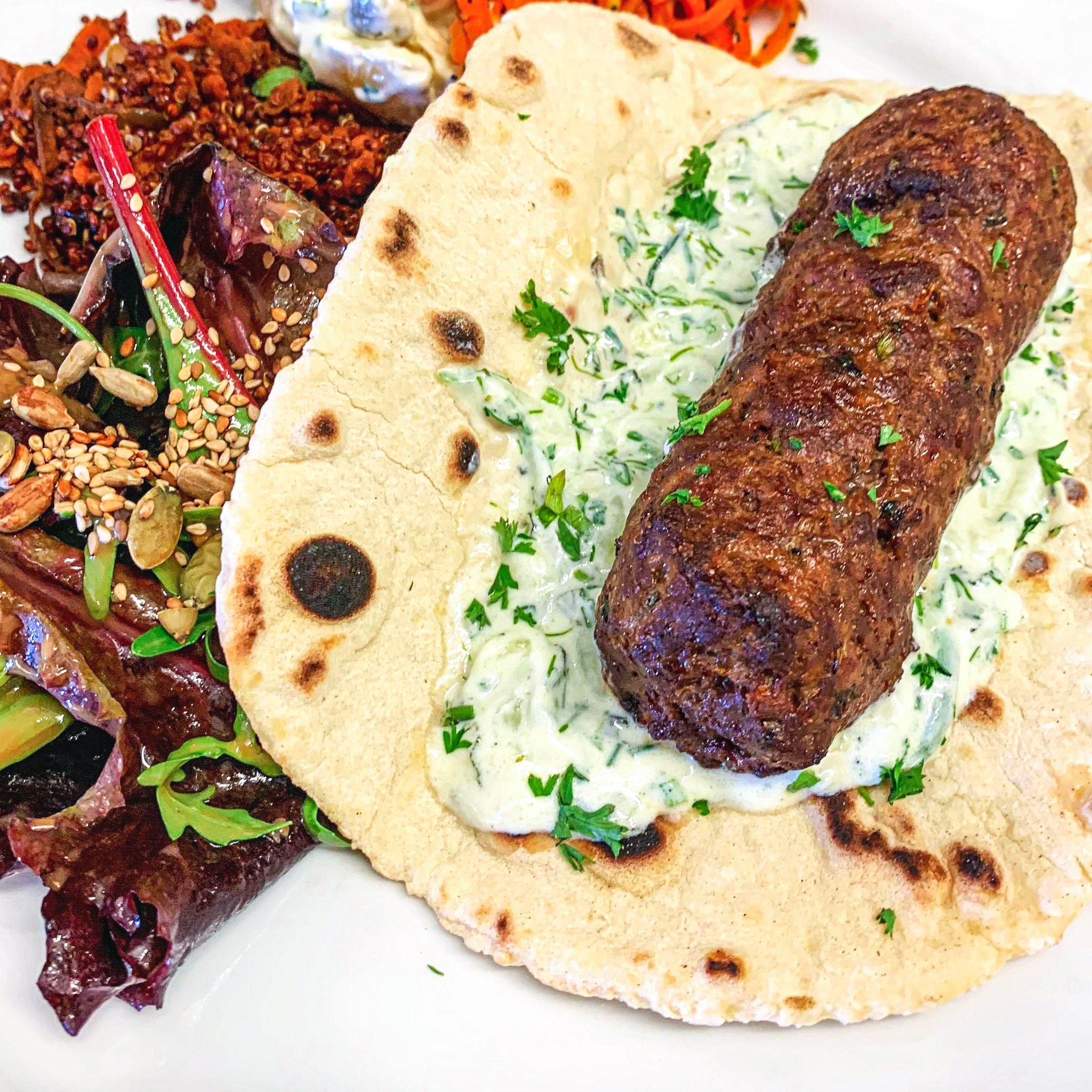Venison Seekh Kebabs with Coriander & Mint Sauce
Majestic Red Deer, one of the two Native Scottish deer species, can be found across the Finzean Estate, alongside the smaller Roe Deer.
Deer are an important part of the wild ecosystem at play here in Finzean, and across the Scottish Highlands. Red Deer graze in our woods and fields over winter, before returning to the heather moorland for most of the spring and summer months, whilst Roe Deer can be found across the lower parts of the estate throughout the year. With no substantial natural predators, such as wolves, remaining in the UK, the population of all deer species has grown greatly, often reaching unsustainable levels.
As such, it is our duty as responsible custodians to control the deer population through selective culling - ensuring plants and young trees are not over-predated by the deer, and providing a ready supply of healthy, wild and sustainable Venison for the local community to enjoy.
Our Gamekeeper Hedge, stalking the woods near Finzean in the snow.
The majority of our deerstalking is carried out by our resident gamekeeper, Hedge. Hedge treks through the woods, over the moor and beyond to find the herds of Red Deer, keeping an eye out for the shy Roe Deer along the way.
He brings them back to our game larder, where Sanjay, Head Chef at the Farm Shop, butchers them into cuts for sale - such as the delicious loins and fillets. We use the venison in our very popular Venison Burgers, as well as for pies, casseroles and curries.
Sanjay says:
“Mince is a really important part of the butchery process, as it’s how you use up all your trimmings from neatening up cuts, as well as for tougher cuts, like shanks, that wouldn’t stew well.”
“I think kebabs like these, packed full of herbs and spices, are a great way to introduce game to people who haven’t tried it before - after all, who doesn’t like a kebab!”
“Indian flavours suit the stronger flavour of Venison really well, and the Coriander & Mint sauce is zingy and delicious.”
You may well have tried these kebabs at our Celebration of Game dinner last October or at one our Curry Nights since then - they were very popular, and we’re delighted to bring you the recipe for them.
We’re also going to have these on the specials board again soon, so if you don’t fancy making them - keep an eye out and come down to the shop to try them!
You can serve these kebabs on a simple flatbread or naan, with salads, for a lovely light summer meal
Venison Seekh Kebab Recipe
You can find Venison Mince in stock at the Farm Shop, either fresh in the chiller, or frozen. It is a seasonal product, so if you’re coming down to get some please do ring ahead, as we sometimes sell out! And if you can’t get any Venison Mince, this recipe would work equally well with Lamb Mince too.
We suggest using Cullisse Rapeseed Oil for this recipe, which is grown in Scotland. This can be found at the Farm Shop alongside all the spices and ingredients required for these kebabs.
If you don’t like Coriander - for some people, it tastes like soap! - you can substitute Parsley instead.
Makes 4-6 medium sized kebabs. Serves 4, when served with naan and salads.
INGREDIENTS
For the Kebabs
80ml rapeseed oil, plus extra to brush the kebabs
300g red onion (1-2 large, ~3 medium)
4 cloves garlic
2” piece of ginger
1 fresh chilli, green or red
2 tbsp medium curry powder
1 tbsp each: ground garam masala, ground cumin, ground coriander, ground black pepper
½ tbsp chilli powder
Bunch fresh coriander (approx 20g)
500g venison mince
Salt, to taste (start with ½ tbsp)
For the Sauce
1 bunch mint
1 bunch coriander
1 green chilli
3 tbsp Greek yoghurt
Salt, to taste
METHOD
To make the Kebab mix
Grate the onion coarsely using a box grater. Add to a small saucepan with the rapeseed oil and saute over a medium heat till soft and starting to colour. They will release a lot of liquid, most of which should boil off. This will take 10-15 minutes
Meanwhile, grind the ginger and garlic to a smooth paste - either using a fine grater, mortar and pestle, or mini food processor. Add the chilli (remove the seeds if you prefer less heat) and grind this to a paste as well.
Add the ginger/garlic/chilli paste to the saucepan with the onions and saute till fragrant. Stir frequently as the garlic will stick - add a splash of water to loosen it if this happens. Cook till any raw smell disappears, and the garlic starts to caramelise.
Remove the saucepan from the heat, and transfer the contents to a sieve set over a bowl. Drain off all the excess liquid - if you add all of this to the mince, it can make the kebab mix too wet and hard to work with.
Add the drained onion mix to a bowl, and combine with all the dry ground spices. Finely chop the coriander leaves and add them to the mix as well. Stir well to ensure all the spices are evenly distributed. Finally, combine the mince with the onions, spices and salt. Use your hands to really incorporate the spices well.
Take a small spoonful of the mix and fry it, if you want to test the spice levels before making the kebabs. You can always add more chilli, but you can’t take it out! If you think the mix is a touch dry, you can incorporate some of the drained onion juices.
Once you’re happy with the mix, it can be stored in the fridge for 3 days. It’s easier to work with once fully chilled (2 hours in the fridge), but you can use the mix straight away if you need to.
For the Coriander & Mint Sauce
Start by picking the leaves from the mint stalks. Then combine the mint leaves, coriander leaves and stalks, chilli and yoghurt in a blender and blitz until smooth. This is best done just before you want to use it.
To Cook the Kebabs.
Shape into kebabs - it’s easiest to do this using a piping bag packed with the mix, onto oiled trays. Aim for a sausage shape about 1” diameter. Thread onto skewers if using - the best are large, flat skewers (Seekhs) from where this kebab gets it’s name. Brush lightly with rapeseed oil. Alternatively, you can shape them using your hands onto soaked bamboo skewers.
These kebabs do best on a charcoal (or gas) BBQ - though be careful when turning them. Grill them for approximately 8 minutes, turning as regularly as possible, and basting with the reserved onion liquid.
They can also be cooked using your oven: under the hottest grill setting or in a very hot (300C) fan oven, for approx 10 minutes. If using a fan oven, the kebabs don’t need to be turned. They should still just be pink in the middle when you take them out - rest for 2 minutes before eating them.



